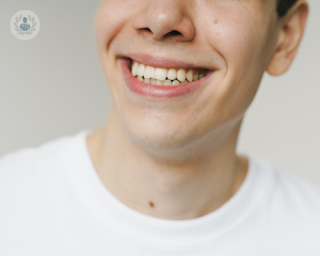Sialendoscopy
Miss Katherine George - Oral & maxillofacial surgery
Created on: 03-18-2024
Updated on: 04-17-2024
Edited by: Carlota Pano
What is sialendoscopy?
Sialendoscopy is a minimally invasive procedure used to diagnose and treat salivary gland disorders. The procedure involves the use of a small, flexible endoscope (a thin tube equipped with a high-definition camera and light source) to examine for any blockages, stones, or other abnormalities.

Why is it done?
Sialendoscopy is performed for various reasons:
- To locate and remove stones causing blockages within the salivary ducts, which can lead to pain, swelling, and infection.
- To identify and treat narrowing or strictures within the ducts, which can obstruct the flow of saliva.
- To investigate and manage recurrent infections or inflammation of the salivary glands.
How to prepare
Prior to the procedure, you will be asked to inform about any medications you are currently taking, including prescription medications, over-the-counter drugs, vitamins, and supplements. You may also be asked not to eat or drink anything for a certain period before the sialendoscopy.
Some patients experience temporary discomfort or drowsiness following the procedure. If you anticipate needing assistance or care, it’s important that you make arrangements for someone to accompany you to the appointment and drive you home afterwards.
How is sialendoscopy performed?
Normally, sialendoscopy is performed under a local anaesthetic, ensuring your comfort throughout the procedure.
During the sialendoscopy, the endoscope will be carefully inserted into the salivary duct through the natural opening in the mouth. This will allow the specialist to visualise the inside of the duct and glands on a monitor in real-time.
Once the endoscope is in place, the specialist will examine the ducts and glands for any abnormalities, such as stones, strictures, or signs of infection. The high-definition camera will provide detailed images, enabling accurate diagnosis of the underlying condition.
If a blockage or other abnormality is detected during the diagnostic process, various specialised instruments will be passed through the endoscope to address the issue. For example, specialised tools may be used to remove salivary stones, dilate strictures, or irrigate the ducts to clear debris.
Throughout the procedure, a saline solution may be gently flushed through the ducts to aid in visualisation and remove any accumulated debris or mucus.
Care after the intervention
After the sialendoscopy, you will typically be monitored for a short period to ensure there are no immediate complications. Some discomfort or swelling may occur, but over-the-counter pain relievers and cold compresses will help alleviate these symptoms.
You will be recommended to drink plenty of fluids to help flush out any remaining debris and promote healing. In some cases, you may also be asked to temporarily avoid hard or spicy foods to minimise irritation to the treated area.
Smoking will impair healing and increase the risk of complications, so it's important that you refrain from smoking during this period.
What is the success rate of sialendoscopy?
Sialendoscopy is a highly effective procedure, with many patients experiencing significant improvement or resolution of symptoms following the procedure.
In cases of salivary gland stones, sialendoscopy has been shown to successfully remove stones in the majority of patients, relieving symptoms such as pain and swelling. Similarly, for conditions like salivary duct strictures or chronic infections, sialendoscopy can effectively identify and treat the underlying issue, leading to improved salivary gland function and reduced symptoms.
It's important, however, that you discuss your specific situation and treatment expectations with the specialist.
Which specialist carries out sialendoscopy procedures?
Sialendoscopy is performed by oral and maxillofacial surgeons and by ENT specialists.


